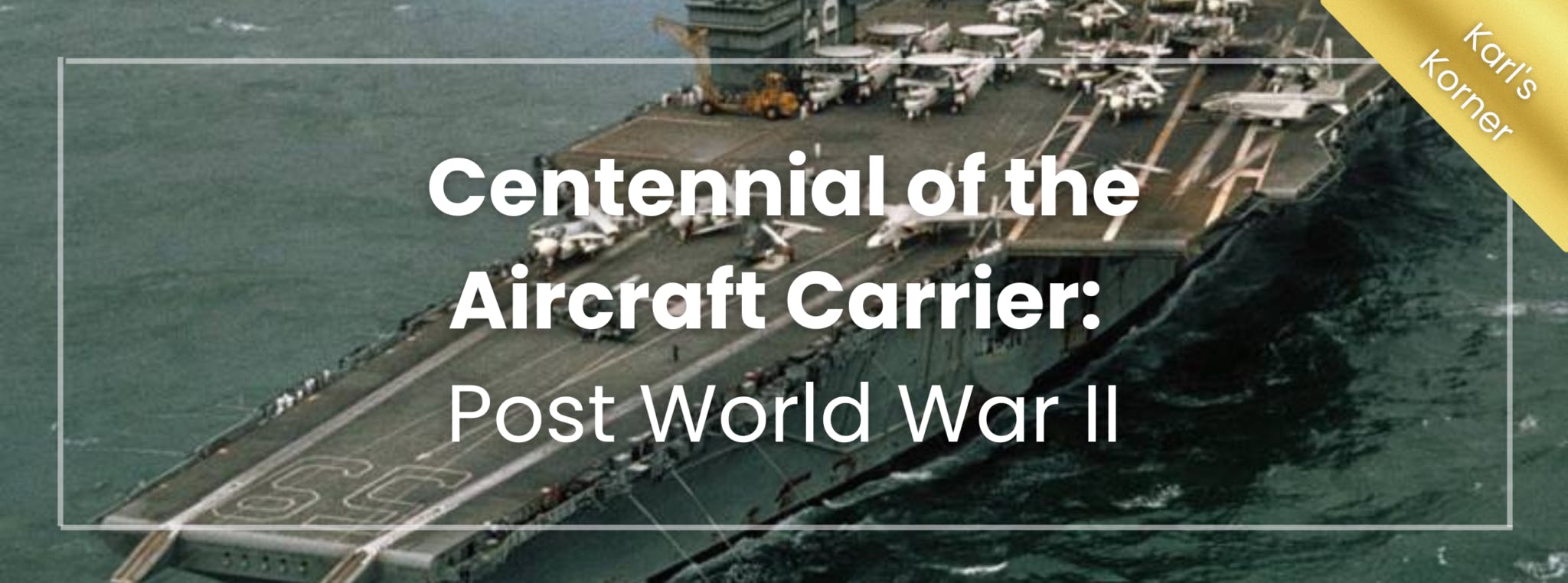 December 21, 2022 | Karl’s Korner
December 21, 2022 | Karl’s KornerCentennial of the Aircraft Carrier: Post-World War II
The towering success of America's aircraft carriers in helping win World War II was followed rapidly by a steep decline in the number of Navy flattops once the war was over. Even the new Essex class carriers, built during the war, were placed into "mothballs," replaced by younger vessels or the new Midway-class battle carriers. Yet, even in that era of peace, ill winds blew in Washington over the eventual fate of carrier aviation. The new Truman administration was keen on returning the American economy to prosperity after decades of depression and war while attempting to stand up to Stalin's Soviet Union in a now bi-polar political world. To address this new U.S. policy, draconian cuts to defense spending occurred across all the services, While Truman bet on the American atomic monopoly to deter the Soviet Union. Both of these approaches threatened sea-based naval aviation directly, particularly at a time when jet aircraft were seen as the way forward for the military. Unfortunately, these newer and faster planes were struggling to adapt to small carrier flight decks. The poor handling of the in-fighting within the Defense Department led to the "Revolt of the Admirals" in 1949, where a Secretary of the Navy, John L. Sullivan, resigned in protest to the cancelation of a new supercarrier, the USS United States, and additional funding shifting to the new U.S. Air Force. In the meantime, only a single aircraft carrier could be maintained on station in the Far East when mainland China fell to communism. The North Korean invasion of its neighbor to the south in June 1950 shocked Washington. It spurred Truman into committing American forces to the Korean peninsula. Within days, however, the usefulness of carriers was once again made readily clear off the coasts of Korea. Japan-based U.S. Air Force aircraft lacked the endurance over Korea, while naval aircraft could range on both sides of the peninsula. By the time of the Korean War armistice in 1953, a number of World War II carriers were being recommissioned and placed back into fleet service. Although early combat jets could serve adequately from flight decks, succeeding designs were becoming unmanageable. Fortunately, the Royal Navy had the same issues and developed a trio of carrier design breakthroughs that saved carrier aviation from technical oblivion. The first was the adaptation of steam technology to aircraft catapults, permitting the launching of heavy jets to flying speed off the flight deck. Next, a new deck design featuring an angled runway and landing area over the hull's port side solved the issue of lethal wire barrier engagements for jets. Finally, the higher landing speeds and shorter reaction times for landing jet aircraft found resolution in a reflected lighting array visible to the pilot throughout his approach. By the mid-1950s, new carriers were built with these innovations, and the older ships still in service were converted. For America, the Cold War developed into a global challenge, and having a fleet of mobile airfields able to launch powerful combat aircraft nearly anywhere, became a prized asset for U.S. presidents. In a long chain of crises, mainly in Asia over the rest of the 20th century, presidents were compelled to deploy the nearest carrier task force to any trouble spot. Occasionally, this was a prelude to a shooting war, such as over Vietnam, where a carrier strike in retaliation against a naval clash in the Gulf Tokin in 1964 was one of the first overt applications of American force in the region. As the conflict developed, carrier deployments off North Vietnam in a region designated "Yankee Station" became routine. With naval aircraft striking from the east and Thailand-based Air Force planes attacking from the west, North Vietnam was subjected to an active air campaign for nearly seven years. As the Vietnam War concluded, new threats emerged in southwest Asia as India and Pakistan clashed. The importance of access to Arabian oil became paramount to Western interests, which required extended carrier deployments into the far-off Indian Ocean. To help take some of the strain off the Navy deployment schedules, the USS Midway (CV-41) was permanently in Yokosuka, Japan, in 1973. Carrier deployments to the western Indian Ocean remain routine, even as the nature of national security threats has morphed over the decades. After the end of the Cold War in the late 1980s, regional warfare brought carriers into combat in response to Iraq's invasion of Kuwait in August 1990. The resultant Operation Desert Storm, the following January, created the largest wartime carrier deployment since 1945. In the new century, turmoil throughout southwest Asia drew in carrier support again, though not necessarily in a direct combatant role. To reach land-locked Afghanistan in 2001, the USS Kitty Hawk became a staging base for Army helicopters as U.S. forces invaded. More conventional air attacks were borne by carriers in Iraq and Afghanistan, often with single-strike aircraft flying missions encompassing more than one target over a wide-ranging area. With the dissolution of a U.S.-Soviet standoff after the Cold War, other navies have embraced carrier aviation. The employment of a ramped platform on the foredeck of carriers brought high-performance naval aviation to nations that could not afford larger, steam-catapult-supported ships. Russia, China, India, Spain, Italy, Australia, Turkey, and Thailand now feature such ships. At the same time, the Royal Navy has returned to full-sized carriers with the Queen Elizabeth class, and France maintains its Charles de Gaulle. With the second century of U.S. carriers starting, applications of new magnetic technology and embracing mixed air wings of piloted and unmanned aircraft point to the future. With decades of ups and downs now past, the role of the carrier remains strong. Launch em’… until next time, Karl
Your Adventure Starts Now
Your email is the key to information that will open up all your possibilities for exploring the mighty Midway!

